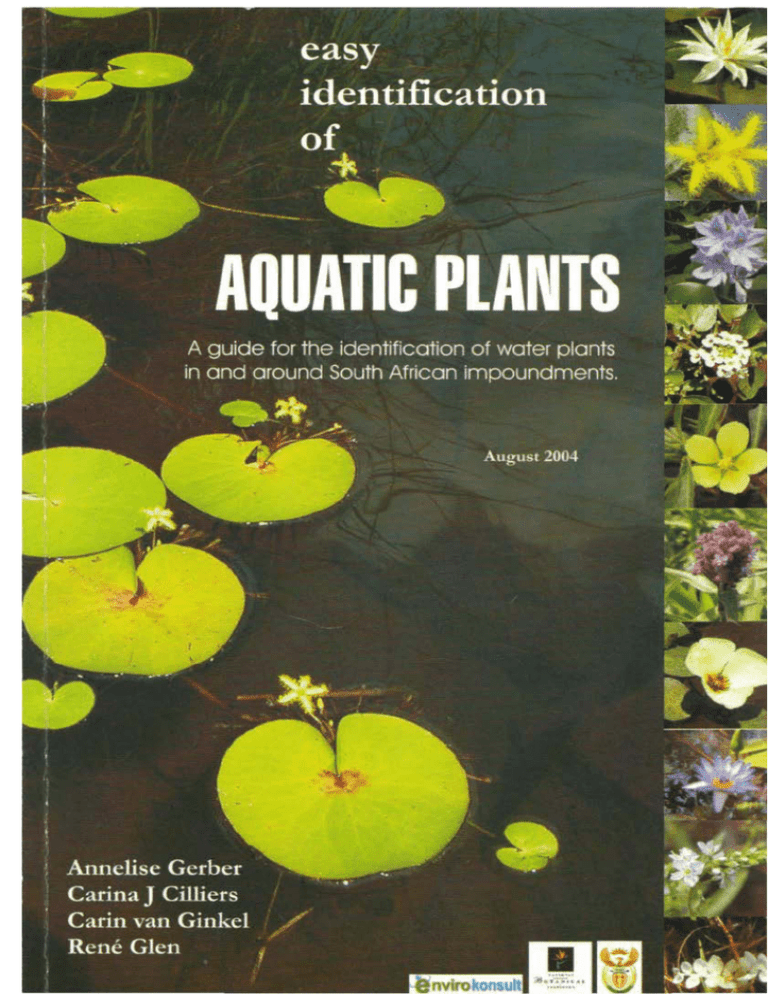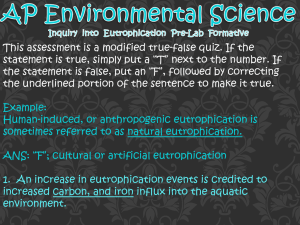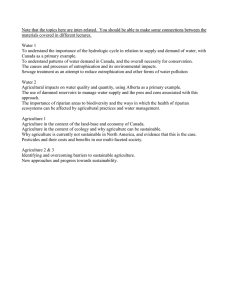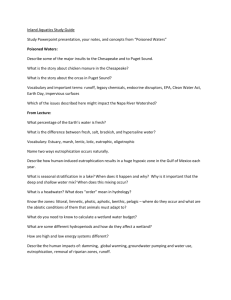
EASY IDENTIFICATION OF AQUATIC
PLANTS
by
Annelise Gerber, Carina J Cilliers,
Carin van Ginkel and Rene Glen
Copyright© 2004 Department of Water Affairs
All rights reserved.
ISBN:
0-621 -35113-X
This publication is available from :
Director; Resource Quality Services (RQS)
Department of Water Affairs and Forestry
Private Bag X 31 3
Pretoria
0001
Tel 012 808 9500
Fax 012 808 2702
or
Annelise Gerber
gerbera@dwaf.gov.za
Task team
Carin van Ginkel (Resource Quality Services, Pretoria)
Plant specimens, photographs, text
Dr Carina Cilliers (Envirokonsult, Pretoria)
Expert advice, plant identification
Rene Glen (Natal Herbarium, National Botanical Institute,
Durban)
Plant identification
Annelise Gerber (Resource Quality Services, Pretoria)
Plant specimens, photographs
Design and layout
Annelise Gerber, Resource Quality Services, Pretoria
Printing and binding
Government Printers, Pretoria
Acknowledgements
National Botanical Institute Pretoria - Distribution maps
Roddy Ward - Photographs of Spirodel/a sp and flowering
Utricu/aria stellaris
National Botanical Institute - Photographs of Potamogeton
thunbergii
ii
Contents
Page
Background
Symbols used in this book
2
Notes on preparation of plant samples for
identification
3
Water plants - Free floating
6
Azol/a tllicutoides, Azol/a pinnata, Eichhornia cross/pes, Lemna gibba,
Pistia statiotes, Satvinia mofesta, Spirodela sp., Wofttia arrhiza
Water plants - Floating-leaved, attached
14
Alternanthera phifoxeroides, Aponogeton distachyos,
Hydroc/eys nymphoides, Nymphaea mexicana, N. nouchalia,
Nympho/des thunbergiana, Trapa natans
Water plants - Submerged
21
Egeria densa, Ceratophylfum demersum, fsofepis flu/tans,
Lagarasiphon major, L. muscoides, Myriophylfum aquaticum,
Najas horrida, Potamogeton crispus, P. pectlnatus, P. schweinturthii,
P. thunbergil, Uticu/aria stelfaris
Water plants - Emergent broad leaved
34
Berufa erecta, Cyctosorus interruptus, Floscopa glomerata,
Ludvvigia adsendens subs. dittusa, Limosel/a motor, Marsifea sp.,
Nasturtium otticinale, Ne/umbo nucifera, Persicaria deciplens,
P. Japathlfolia, P. senega/ensis, Plantago longlssima, Pontederia cordata,
Veronica anagallis-aquatica
Water plants - Emergent narrow leaved
48
Arundo donax, Carex austro-atricana, C/adium marlscus, Cyperus dives,
C. eragrostis, C. marginatus, C. sexangu/aris, Eleocharis acutangula,
Juncus ettusus, J. fomatophyl/us, Phragm/tes austra/is, P. mauritianum,
Prionium serratum, Schoenoplectus brachyceras, S. pafudico/a,
Typha capensis
Bibliography
64
Index of names
66
Appendix I
69
Appendix 11
72
iii
Background
Eutrophication is the process of excessive nutrient enrichment of
waters that typically results in problems associated with aquatic
plants, algal and cyanobacterial growth.
In natural lakes a distinction is sometimes made between
'natural' and 'cultural' (anthropogenic) eutrophication processes
(e.g. Rast and Thornton (1996)) . Natural eutrophication depends
only on the local geology and natural features of the catchment.
Cultural eutrophication is associated with human activities that
accelerate the eutrophication process beyond the rate
associated with the natural process (e.g. by increasing nutrient
loads into aquatic ecosystems). In South Africa where
impoundments are man-made, the conceptual difference
between 'natural' and 'cultural' seems less appropriate.
Increased nutrient enrichment can arise from both point and
non-point sources external to the impoundment as well as
internal sources like the impoundment's own sediments (that can
release phosphate). Much eutrophication-related monitoring has
been done in South Africa over the past three decades. Before
the promulgation of the National Water Act No.36 of 1998 there
was no legal requirement to assess the degree of eutrophication
at a national level. However this act now requires monitoring,
recording, assessment and d issemination of information on
national water resources. The National Eutrophication Monitoring
Programme (NEMP) specifically addresses the monitoring
requirement in respect of eutrophication.
The need for an aquatic plant identification manual was
identified during the design of the National Eutrophication
Monitoring Programme, where the extent of aquatic water plant
growth are one of the variables to be monitored. Excessive water
plant growth, also of indigenous plants, is an indication of
eutrophication and/or habitat disturbance.
The purpose of this field identification manual is to assist NEMP
monitors with photographs of the plants, flowers and habitat to
identify aquatic water plants for monitoring purposes.
1
8
Roodeplaat Dam
~
Beru/a erecta
@J
~.. tandpynwortel
\.'
.................
34
toothache root
Steelpoort River, Lyden burg area
BIBLIOGRAPHY
Cook, C.D.K. 2004. Aquatic and Wet/and Plants of
Southern Africa. Barkhuys Publishers, Leiden .
Fish, L. 1999. Preparing herbarium specimens. Strelitzia
series no. 7. National Botanical institute, Pretoria .
Henderson, L. & Cilliers, C.J. 2002 . Invasive Aquatic
Plants. ARC plant protection Research Institute, Pretoria,
South Africa.
Pooley, E. 1998. A Field Guide to Wild Flowers.
Kwazulu -Natal and Eastern region. Natal Flora
Publications Trust.
Sainty, G.R & Jacobs, S.W.L. 1994. Waterplants in
Australia. Sainty and Associates, Darlinghurst.
Staff of the Botanical Research Institute. 1980a-r.
Farming in South Africa, Water Plants Series W.1-20:
1980a. Water fern (Azolla filiculoides Lam.). W.16
1980b. Water hyacinth (Eichhornia crassipes(Mart.)
Solms) . W7
1980c. Kariba weed (Salvinia molesta Mitchell). W.8
1980d. Parrot's feather (Myriophyllum aquaticum (Ve il.)
Verdc.) .W.9
1980e. Floating pondweed (Potamogeton thunbergii
Cham. & Schlechtd.) W.1
1980f. Fennel-leaved pondweed (Potamogeton
pectinatus L.) . W. 2
64
1980g. Broad-leaved pondweed (Potamogeton
schweinfurthii A. Benn .). W.4
1980h. Curled pondweed (Potamogeton crispus L.) .
W.15
1980i. Saw-weed (Najas pectinata (Pari.) Magnus) .
W.13
1980j. Water hornwort (Ceratophyllum demersum L.) .
W.17
1980k. Coarse oxygen weed (Lagarasiphon major
(Ridley) Moss ex wager) . W. 18
19801. Fine oxygen weed (Lagarasiphon muscoides
Harv.). W. 19
1980m. Willow-herb (Ludwigia stolonifera) . W. 16
1980n. Blue water lily (Nymphaea caerulea Sav.).
W.12
1980o. Floating heart (Nymphoides indica L. subsp.
occidentalis A. Raynal). W. 14
1980p. Bulrush (Typha capensis (Rohrb.) N.E. Br.) W.3
1980q. Duckweed (Lemna gibba L.) . W.20
1980r. Star bladderwort (Utricularia stellaris L.f.) . W. 10
Van Wyk, B & Malan, S. 1998. Field Guide to the Wild
Flowers of the Highveld. Struik publishers.
65
juncus.
le:;~fy
57
Pistia stratiotes 10
krulblaarfonteinkruid 29
Plantago longissima 45
Lagarasiphon major 25
plantago, broadleaved 45
Lagarasiphon muscoides 26
pondweed , broad-leaved 31
leafy juncus 57
pondweed , curled 29
Lemna gibba 9
pondweed , fennel-leaved 30
lettuce, water 10
Pontederia cordata 46
Limosella maior 38
poppy, water 16
lotus 41
Potamogeton crispus 29
Ludwigia adsendens subsp. diffusa 37
Potamogeton pectinatus 30
Ludwigia stolonifera 37
Potamogeton schweinfurthii 31
Marsilea sp. 39
Potamogeton thunbergii 32
matjiesgoed 54
Prionium serratum 60
Myriophyllum aquaticum 27
red water fern 6, 7
Najas horrida 28
reed , common 58
Nasturtium officinale 40
reed , giant 48
Ne/umbo nucifera 41
pondweed , floating 32
Nymphaea mexicana 17
reed , water 61
Nymphaea nouchalia var coerulea 18
reed , thatching 59
Nymphaea sp. 19
reuse rietgras 51
Nymphoides thunbergiana 20
riet , spaanse 48
oxygen weed , coarse 25
rietgras , reuse 51
oxygen weed , fine 26
rooiwatervaring 6, 7
palmiet 60
root, snake 44
papkuil 63
root, toothache 34
parrot's feather 27
rush 49, 52, 56
Persicaria decipiens 42
saagtandwatergras 50
Persicaria lapathifolia 43
salvinia
Persicaria senega/ensis 44
Salvinia molesta 11
Phragmites australis 58
saw weed 28
Phragmites mauritianum 59
sawgrass 50
pickerel weed 46
Schoenoplectus brachyceras 61
11
67
APPENDIX 1
Solution for the preservation of aquatic plants
69
APPENDIX 2
Factsheet required by NBI for
identification of plants
71
Collector:
.. ..... ........... .... ... .... .... .. ... . .. ...... No: ................ ... .. .. Date: .. .
Provisional name:
Region:
GPS
Locality
Biome
I
Grid :
s
Forest
I Nama Karoo
I Grassland
Fynbos
I
Savanna
Alt:
ftlm
E
I
Succulent Karoo
I
Thicket
Vegetation
Type
Habitat
mountain peak
talus/scree
I mountain slope I hilltop I hill slope I ridge I cliff face I ravine/kloof/gorge
I plateau I valley I floodplain waterfall I river/stream bank I river/stream
I
dry stream bed
seepage
lake
well-drained
moist/damp
gravel
I
I
pond
I
leaf
I
I
I
pan
plain
I
gravel
loam
I
I
granite
shade
parasite
saprophyte
Plant features
I
I
I
I
I
swamp
lagoon
I
in water
SE
I
free standing water
I
I
I
running water
humus
quartzite
I
I
full sun
succulent
lithophyte
I
bare rock
I
I
I
black turf
I
I partial shade
I
N I s I w I E I NE I NW
abandoned land I cultivated land
plantation I grazed I disturbed
tree
shrub I dwarf shrub
shale
marsh
littoral
I other:
roots
seasonally waterlogged
I
sand
I
estuary
I wetland
I sea
other:
rocky soil
leaf litter
I
depression
dune (coastal)
permanently waterlogged
sandstone
climber
Flowers:
Notes
I
stony soil
bark
Moisture
regime
Soil type
Lithology
Exposure
Aspect
Biotic
effect
Life form
donga/gully/ditch
dune (desert)
dam
soil
Substrate
I
clay
calcrete
I
I
Slope
I SW
saltlbrack
I
moderate
none seen
I
I
mist/fog
baserock
I
dolomite
none
recently burned
I
I
I
dolerite
gentle
steep
I
garden
roadside
other:
I
graminoid
hydrophyte
I
tidal
other:
pasture
herb
termite mound
I
geophyte
bryophyte
I
lichen
I
I
epiphyte
scrambler
other:
(underground parts, bark, leaves, flowers , fruit , seeds, aroma)
present
Fruit:
absent
present
absent
Plant height:
m
(local abundance, phenology, pollinators , herbivory, economic & ethnobotanical factors ,
voucher specimen)
Voucher:
photo
ecology
cytology
anatomy
seed
spirit
Plant name:
Genspec
.. ./
........ Det
Date
.. .. ... No. of labels
73




